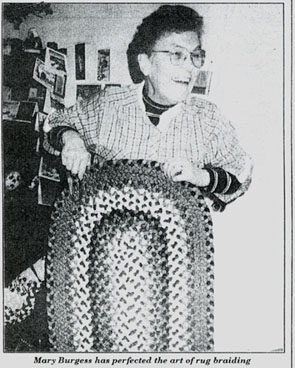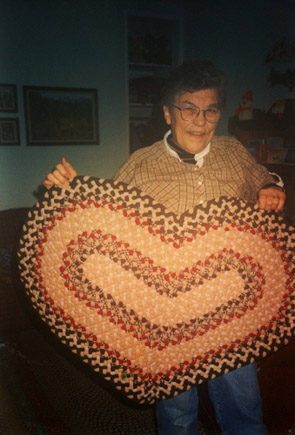 Braiding Multiple Talents into a Full Life
Braiding Multiple Talents into a Full Life
By Louise Lindgren
~ Braiding Multiple Talents into a Full Life
It’s a wonder the Burgess’ dump truck doesn’t have braided rug seats. After all, one of the drivers of that truck has made rug braiding a specialty.
Mary Burgess is admittedly a “country girl,” and has acquired all the skills normally ascribed to those of that upbringing, plus a few more. She can bake, garden, sew and braid rugs. She can pound nails swift and straight, ride a horse, act as a packer to a hunter or helper to a surveyor. Her paintbrush might hold house paint one day and oil paints for a canvas the next. And, she can drive heavy machinery if road work must be done.
What sets her apart is her willingness to learn just about anything and become not only proficient, but a perfectionist in each pursuit. She doesn’t just braid rugs – she teaches the art. She doesn’t simply cook – she researches exceptional magazines and books to find the most nutritionally sound methods of preparing foods. As for heavy machinery, years of helping her husband maintain roads for their Mt. Index community has given her more experience handling intimidating large machines than most men will ever have.
Why would a petite, seemingly “normal” woman who keeps an immaculate house be interested in mastering so many skills? Perhaps it goes back to her childhood; perhaps it’s just personality. Who knows how adventurous minds are bred or why they develop?
The background is clear – pure country. Born in Star, a now-defunct spot on the map in the Bohemia Mountains of southern Oregon, Burgess learned early on about sagebrush farming, including how to milk a cow at age six. Several moves were made during early childhood – from valleys to mountain territory, Oregon to Northern California. Finally, the family made the long trip north to homestead 80 acres in the Kittitas Valley of eastern Washington. The nearest town was Ellensburg, definitely just a town, not a city, when she was a girl. There they dug the canals and ditches which would bring irrigation to that sagebrush country and forever change the face of the land along the Columbia River.
Lessons ingrained upon young Mary’s consciousness included frugality and water conservation. “We used to re-use the water several times,” she recalls. “Leftover wash water was used to mop floors, and water left over from that was poured on the plants. We didn’t waste a drop! Those were Depression years [of the 1930s],” Mary remembers. “Still, I think we had as much fun as the kids of today – maybe even more, because we were forced to use our imaginations.” She learned to sew when flour sacks were the ever-present fabric for dish towels, curtains, aprons, and dresses for small children.
Mary learned by acute observation. There were all the normal farm chores to do, fences to mend, animals to care for, buildings to maintain. Always one who enjoyed being out “doing things” with her father rather than pursuing the gentler arts of the home, she became adept at such skills as pounding nails. This stood her in good stead at the Salinas County Fair when, years later as a young woman, she entered a nail pounding contest. On her initial attempt, she tied for first place. A glance at the technique of her competition immediately taught her how to win. The second time around, instead of “placing” the nail with just a tap on the first swing, she says, “I hit it hard, ‘Pow!’ and won myself five dollars!”
Married at age 16, she began raising a family of three boys. During the Second World War she worked at a motor company in Indiana that was making airplane parts. She discounts herself as a “Rosie the Riveter” because, she says, “We didn’t rivet. We drilled three holes in each part, then reamed them smooth, over and over again. The hard part was that they kept rotating shifts, and though I had to work graveyard, I couldn’t sleep during the day.” There was always the challenge of providing adequate childcare for three small boys.
Finally, with her marriage ended, Mary settled in Washington, becoming a cook, first on a ranch, then in restaurants. “At the ranch they left me on my own from the first, and it was pretty bewildering, but I got the hang of it,” she recalls. “The workday was a lot longer [than cooking for restaurants], but the time between meals was your own. I would help on the farm or do craft work until it was time to start food preparation again.” Restaurant work won out because the money was better and the schedule more regular.
Many years passed, and Mary endured her full share of personal tragedies before she met and married Neil Burgess, a trained surveyor. Tempered steel is strongest, and Neil appreciated that strength in her as their lives evolved at the base of Mt. Index. For the first time, she had a home on the west side of the Cascade Mountains. The soggy climate and moisture-laden cold that creeps into one’s bones in the mountains did not dampen her enthusiasm for trying something new. The newlyweds bought three lots on the South Fork of the Skykomish River and proceeded to build a home from rough-sawn lumber they cut and milled themselves on the site. At the time there were only two families living full-time in the area; others came for weekend stays in their mountain cabins.
Access was by unpaved road that required constant maintenance. Gradually, the Burgesses became maintainers of the road, acquiring equipment as needed. If a job needed doing, Mary Burgess wanted to help. Thus she learned her first hard lessons in handling heavy equipment. One time while dumping a load of wet gravel, the back truck-gate refused to open. She had already learned that to spread gravel evenly, the truck must be in forward motion as the gate opens. As she moved out, raising the bed and expecting a flow of gravel from the back, the gate stuck, trapping thousands of pounds of gravel at the rear and tipping the whole truck on its hind end.
“It sure looked like a long way down to the road from my perch up in that cab,” she remembers with a laugh. “I had to climb out and sort of slide down the side to the back wheel before I could jump down. Then we shoveled and shoveled to lighten the load, but eventually Neil had to pull that truck down with a chain hooked on to the grader.”
Lessons are learned quickly when fear becomes a factor. There was a time when the airbrakes failed as she drove the truck down a steep hill. She says, “Somehow I managed to stay in control and just kept shifting into lower gears until I could coast out onto Alder Flats.” Mary observes that when you lose your brakes, the vehicle seems to lurch forward even though the speed remains the same. In a truck of several tons that is a frightening feeling.
As the area became more settled, Neil Burgess was much in demand as a surveyor. Since that is definitely a two-person job and part-time help hard to come by, Mary offered to work with him. For years she watched the art of surveying change from the chain and transit method to modern laser equipment, and tramped many a section line to go ahead with the target while her husband made his calculations. It is not an easy job on rough terrain in dense underbrush, which has to be cleared to provide a “line of sight.” When she started there were no women that she knew of doing that sort of work. Now she says, “You see more and more of them. I guess I started a trend.”
The Burgesses were always amused when starting their surveys at a documented monument in a town. Invariably, someone would ask, “Are you surveying this town again?” In fact they were not surveying the town at all. One has to start at a documented marker in order to legally arrive at the survey area, which may be quite a way from that marked point. Mary says, “People don’t realize that they can’t just tell you where they think their property corner is. They expect you to go from that to find the other corners, but it’s totally illegal.”
The Burgesses were always amused when starting their surveys at a documented monument in a town. Invariably, someone would ask, “Are you surveying this town again?” In fact they were not surveying the town at all. One has to start at a documented marker in order to legally arrive at the survey area, which may be quite a way from that marked point. Mary says, “People don’t realize that they can’t just tell you where they think their property corner is. They expect you to go from that to find the other corners, but it’s totally illegal.”
 In her rare spare time, Mary reads ancient and western history extensively and paints with oils and acrylics. While the dream home had to be put on hold to deal with her husband’s increasing health problems, she pursued medical knowledge to help solve some of those problems and get them “back on track.” With the passing of her husband in 2006, she has moved to the east coast where she continues to share her special skills with family and new friends. In the end, many are benefiting from her relentless pursuit of knowledge and perfection.
In her rare spare time, Mary reads ancient and western history extensively and paints with oils and acrylics. While the dream home had to be put on hold to deal with her husband’s increasing health problems, she pursued medical knowledge to help solve some of those problems and get them “back on track.” With the passing of her husband in 2006, she has moved to the east coast where she continues to share her special skills with family and new friends. In the end, many are benefiting from her relentless pursuit of knowledge and perfection.
“Photo courtesy of the Burgess family album” 1988.
Sources: Edited from an article first published in The Third Age Newspaper, February, 1993; interview with Mary Burgess, December, 1992
© 1992 Louise Lindgren All Rights Reserved. WLP Story # 11
